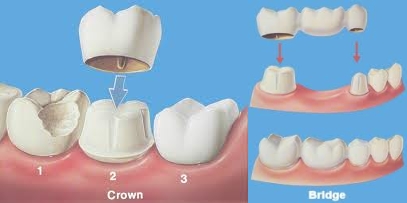
Crowns are often the best way to save a tooth that has been weakened due to tooth decay, root canal or trauma. A crown fits over the existing natural tooth and replaces the natural crown, the part of the tooth seen above the gums.
Bridges replace one or more missing teeth. They consist of an artificial tooth anchored to the natural teeth on each side of the gap.
Crowns and bridges are usually made of porcelain and gold alloy. Porcelain is strong and can be made to match the colour of the natural teeth. It is resistant to staining and can be cleaned if it becomes stained. Gold alloy is used for its strength, hardness and durability. It is especially useful for molars which must withstand the forces of grinding and crushing.
Preparation for a Crown
- After local anaesthetic, the tooth is shaped using a drill, making it smaller by one or two millimetres.
- An impression is then taken to record the changes to the prepared tooth.
- Impressions are then sent to a dental laboratory which makes the crown according to specifications set by the dentist.
- A temporary crown is then cemented to protect the prepared tooth.
- At the next appointment, the temporary crown is removed and the new crown is placed to check that the shape and colour properly matches the reshaped tooth.
- If they do, the crown is then cemented on to the prepared tooth.
- After fitting, the crown should feel natural in your mouth. The dentist will test your occlusion by relying on what you say about the feel of your bite, so you should mention any uncomfortable or strange sensations.
- Minor adjustments may often be needed to achieve comfort.
Preparation for a Bridge
The steps in preparing and fitting a bridge are similar to those for a crown.
- The teeth on either side of the gap are shaped by drilling.
- These teeth are fitted with crowns which serve as anchors for the replacement tooth that is attached to the framework of the adjacent crowns.
- The whole piece is then cemented firmly in place.
Hygiene and Care

Crowns and bridges should last for many years. However, there is no lifetime guarantee. Here are some way that can help prolong your crowns and bridges:
- Maintaining good dental hygiene and oral health
- Regular dental check ups.
- Regular flossing and brushing, with extra attention around the margins where decay is more likely.
If you are in need of treatment or have any inquiries, please do not hesitate to contact Drummoyne Dental Practice at 9181 2226.